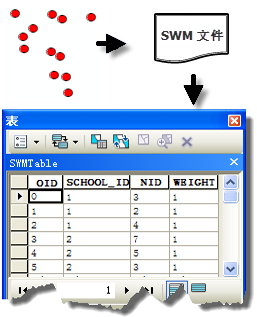| 标注 | 说明 | 数据类型 |
输入空间权重矩阵文件 | 要转换的空间权重矩阵文件 (.swm) 的完整路径名。 | File |
输出表 | 要创建的表的完整路径名。 | Table |
摘要
用于将二进制空间权重矩阵文件 (.swm) 转换为表。
插图

使用情况
参数
arcpy.stats.ConvertSpatialWeightsMatrixtoTable(Input_Spatial_Weights_Matrix_File, Output_Table)
| 名称 | 说明 | 数据类型 |
Input_Spatial_Weights_Matrix_File | 要转换的空间权重矩阵文件 (.swm) 的完整路径名。 | File |
Output_Table | 要创建的表的完整路径名。 | Table |
代码示例
以下 Python 窗口脚本演示了如何使用 ConvertSpatialWeightsMatrixtoTable 函数。
import arcpy
arcpy.env.workspace = "c:/data"
arcpy.ConvertSpatialWeightsMatrixtoTable_stats("euclidean6Neighs.swm", "euclidean6Neighs.dbf")以下独立 Python 脚本演示了如何使用 ConvertSpatialWeightsMatrixtoTable 函数。
# Create a Spatial Weights Matrix based on Network Data
# Import system modules
import arcpy
# Set property to overwrite existing output
arcpy.env.overwriteOutput = True
# Local variables...
workspace = r"C:\Data\USCounties\US"
# Set the current workspace (to avoid having to specify the full path to the
# feature classes each time)
arcpy.env.workspace = workspace
# Create Spatial Weights Matrix
# Process: Generate Spatial Weights Matrix...
swm = arcpy.stats.GenerateSpatialWeightsMatrix("USCounties.shp", "MYID",
"euclidean6Neighs.swm",
"K_NEAREST_NEIGHBORS",
"#", "#", "#", 6)
# Dump Spatial Weights to Database Table
# Process: Convert Spatial Weights Matrix to Table...
dbf = arcpy.stats.ConvertSpatialWeightsMatrixtoTable("euclidean6Neighs.swm",
"euclidean6Neighs.dbf")
# Now you can edit the spatial weights (add, subtract and alter
# neighbors and weights)
# Read weights from table back into Spatial Weights Matrix format
# Process: Generate Spatial Weights Matrix...
swm = arcpy.stats.GenerateSpatialWeightsMatrix("USCounties.shp", "MYID",
"euclidean6Neighs.swm",
"CONVERT_TABLE",
"#", "#", "#", "#", "#", "#",
"euclidean6Neighs.dbf")